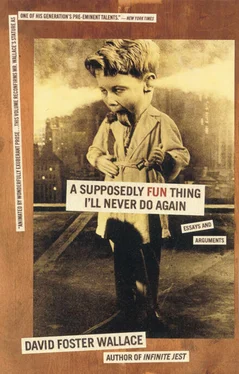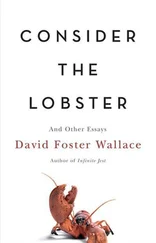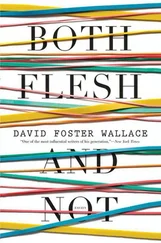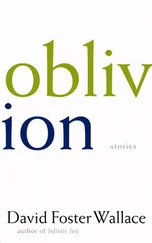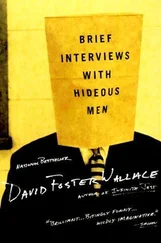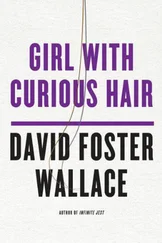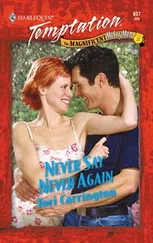You could call this idea of evil Gnostic, or Taoist, or neo-Hegelian, but it’s also Lynchian, because what Lynch’s movies 52are all about is creating a narrative space where this idea can be worked out in its fullest detail and to its most uncomfortable consequences.
And Lynch pays a heavy price — both critically and financially — for trying to explore worlds like this. Because we Americans like our art’s moral world to be cleanly limned and clearly demarcated, neat and tidy. In many respects it seems we need our art to be morally comfortable, and the intellectual gymnastics we’ll go through to extract a black-and-white ethics from a piece of art we like are shocking if you stop and look closely at them. For example, the supposed ethical structure Lynch is most applauded for is the “Seamy Underside” structure, the idea that dark forces roil and passions seethe beneath the green lawns and PTA potlucks of Anytown, USA. 53American critics who like Lynch applaud his “genius for penetrating the civilized surface of everyday life to discover the strange, perverse passions beneath” and his movies for providing “the password to an inner sanctum of horror and desire” and “evocations of the malevolent forces at work beneath nostalgic constructs.”
It’s little wonder that Lynch gets accused of voyeurism: critics have to make Lynch a voyeur in order to approve something like Blue Velvet from within a conventional moral framework that has Good on top/outside and Evil below/within. The fact is that critics grotesquely misread Lynch when they see this idea of perversity “ beneath ” and horror “ hidden ” as central to his movies’ moral structure.
Interpreting Blue Velvet , for example, as a film centrally concerned with “a boy discovering corruption in the heart of a town” 54is about as obtuse as looking at the robin perched on the Beaumonts’ window-sill at the movie’s end and ignoring the writhing beetle the robin’s got in its beak. 55The fact is that Blue Velvet is basically a coming-of-age movie, and, while the brutal rape Jeffrey watches from Dorothy’s closet might be the movie’s most horrifying scene, the real horror in the movie surrounds discoveries that Jeffrey makes about himself — for example, the discovery that a part of him is excited by what he sees Frank Booth do to Dorothy Vallens. 56Frank’s use, during the rape, of the words “Mommy” and “Daddy,” the similarity between the gas mask Frank breathes through in extremis and the oxygen mask we’ve just seen Jeffrey’s dad wearing in the hospital — this kind of stuff isn’t there just to reinforce the Primal Scene aspect of the rape. The stuff’s also there clearly to suggest that Frank Booth is, in a certain deep way, Jeffrey’s “father,” that the Darkness inside Frank is also encoded in Jeffrey. Gee-whiz Jeffrey’s discovery not of dark Frank but of his own dark affinities with Frank is the engine of the movie’s anxiety. Note for example that the long and somewhat heavy angst-dream Jeffrey suffers in the film’s second act occurs not after he has watched Frank brutalize Dorothy but after he, Jeffrey, has consented to hit Dorothy during sex.
There are enough heavy clues like this to set up, for any marginally attentive viewer, what is Blue Velvet ’s real climax, and its point. The climax comes unusually early, 57near the end of the film’s second act. It’s the moment when Frank turns around to look at Jeffrey in the back seat of the car and says “You’re like me .” This moment is shot from Jeffrey’s visual perspective, so that when Frank turns around in the seat he speaks both to Jeffrey and to us. And here Jeffrey — who’s whacked Dorothy and liked it — is made exceedingly uncomfortable indeed; and so — if we recall that we too peeked through those closet-vents at Frank’s feast of sexual fascism, and regarded, with critics, this scene as the film’s most riveting — are we. When Frank says “ You’re like me,” Jeffrey’s response is to lunge wildly forward in the back seat and punch Frank in the nose — a brutally primal response that seems rather more typical of Frank than of Jeffrey, notice. In the film’s audience, I, to whom Frank has also just claimed kinship, have no such luxury of violent release; I pretty much just have to sit there and be uncomfortable. 58
And I emphatically do not like to be made uncomfortable when I go to see a movie. I like my heroes virtuous and my victims pathetic and my villains’ villainy clearly established and primly disapproved by both plot and camera. When I go to movies that have various kinds of hideousness in them, I like to have my own fundamental difference from sadists and fascists and voyeurs and psychos and Bad People unambiguously confirmed and assured by those movies. I like to judge. I like to be allowed to root for Justice To Be Done without the slight squirmy suspicion (so prevalent and depressing in real moral life) that Justice probably wouldn’t be all that keen on certain parts of my character, either.
I dont know whether you are like me in these regards or not… though from the characterizations and moral structures in the U.S. movies that do well at the box-office I deduce that there must be rather a lot of Americans who are exactly like me.
I submit that we also, as an audience, really like the idea of secret and scandalous immoralities unearthed and dragged into the light and exposed. We like this stuff because secrets’ exposure in a movie creates in us impressions of epistemological privilege, of “penetrating the civilized surface of everyday life to discover the strange, perverse passions beneath.” This isn’t surprising: knowledge is power, and we (I, anyway) like to feel powerful. But we also like the idea of “secrets,” “of malevolent forces at work beneath … ” so much because we like to see confirmed our fervent hope that most bad and seamy stuff really is secret, “locked away” or “under the surface.” We hope fervently that this is so because we need to be able to believe that our own hideousnesses and Darknesses are secret. Otherwise we get uncomfortable. And, as part of an audience, if a movie is structured in such a way that the distinction between surface/Light/good and secret/Dark/evil is messed with — in other words, not a structure whereby Dark Secrets are winched ex machina up to the Lit Surface to be purified by my judgment, but rather a structure in which Respectable Surfaces and Seamy Undersides are mingled, integrated, literally mixed up —I am going to be made acutely uncomfortable. And in response to my discomfort I’m going to do one of two things: I’m either going to find some way to punish the movie for making me uncomfortable, or I’m going to find a way to interpret the movie that eliminates as much of the discomfort as possible. From my survey of published work on Lynch’s films, I can assure you that just about every established professional reviewer and critic has chosen one or the other of these responses.
I know this all looks kind of abstract and general. Consider the specific example of Twin Peaks ’s career. Its basic structure was the good old murder-whose-investigation-opens-a-can-of-worms formula that’s right out of Noir 101—the search for Laura Palmer’s killer yields postmortem revelations of a double life (Laura Palmer = Homecoming Queen by Day & Laura Palmer = Tormented Coke-Whore by Night) that mirrored a whole town’s moral schizophrenia. The show’s first season, in which the plot movement consisted mostly of more and more subsurface hideousnesses being uncovered and exposed, was a huge smash. By the second season, though, the mystery-and-investigation structure’s own logic began to compel the show to start getting more focused and explicit about who or what was actually responsible for Laura’s murder. And the more explicit Twin Peaks tried to get, the less popular the series became. The mystery’s final “resolution,” in particular, was felt by critics and audiences alike to be deeply unsatisfying. And it was. The “Bob”/Leland/Evil Owl stuff was fuzzy and not very well rendered, 59but the really deep dissatisfaction — the one that made audiences feel screwed and betrayed and fueled the critical backlash against the idea of Lynch as Genius Auteur — was, I submit, a moral one. I submit that Laura Palmer’s exhaustively revealed “sins” required, by the moral logic of American mass entertainment, that the circumstances of her death turn out to be causally related to those sins. We as an audience have certain core certainties about sowing and reaping, and these certainties need to be affirmed and massaged. 60When they were not, and as it became increasingly clear that they were not going to be, Twin Peaks ’s ratings fell off the shelf, and critics began to bemoan this once “daring” and “imaginative” series’ decline into “self-reference” and “mannered incoherence.”
Читать дальше
